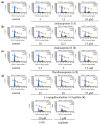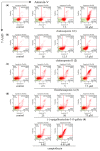The Antiproliferative Effect of Chakasaponins I and II, Floratheasaponin A, and Epigallocatechin 3-O-Gallate Isolated from Camellia sinensis on Human Digestive Tract Carcinoma Cell Lines
- PMID: 27898032
- PMCID: PMC5187779
- DOI: 10.3390/ijms17121979
The Antiproliferative Effect of Chakasaponins I and II, Floratheasaponin A, and Epigallocatechin 3-O-Gallate Isolated from Camellia sinensis on Human Digestive Tract Carcinoma Cell Lines
Abstract
Acylated oleanane-type triterpene saponins, namely chakasaponins I (1) and II (2), floratheasaponin A (3), and their analogs, together with catechins-including (-)-epigallocatechin 3-O-gallate (4), flavonoids, and caffeine-have been isolated as characteristic functional constituents from the extracts of "tea flower", the flower buds of Camellia sinensis (Theaceae), which have common components with that of the leaf part. These isolates exhibited antiproliferative activities against human digestive tract carcinoma HSC-2, HSC-4, MKN-45, and Caco-2 cells. The antiproliferative activities of the saponins (1-3, IC50 = 4.4-14.1, 6.2-18.2, 4.5-17.3, and 19.3-40.6 µM, respectively) were more potent than those of catechins, flavonoids, and caffeine. To characterize the mechanisms of action of principal saponin constituents 1-3, a flow cytometric analysis using annexin-V/7-aminoactinomycin D (7-AAD) double staining in HSC-2 cells was performed. The percentage of apoptotic cells increased in a concentration-dependent manner. DNA fragmentation and caspase-3/7 activation were also detected after 48 h. These results suggested that antiproliferative activities of 1-3 induce apoptotic cell death via activation of caspase-3/7.
Keywords: (–)-epigallocatechin 3-O-gallate; Camellia sinensis; anti-proliferative activity; apoptosis; chakasaponin; floratheasaponin; tea flower.
Conflict of interest statement
The authors declare no conflict of interest.
Figures







Similar articles
-
Standardized Saponin Extract from Baiye No.1 Tea (Camellia sinensis) Flowers Induced S Phase Cell Cycle Arrest and Apoptosis via AKT-MDM2-p53 Signaling Pathway in Ovarian Cancer Cells.Molecules. 2020 Jul 31;25(15):3515. doi: 10.3390/molecules25153515. Molecules. 2020. PMID: 32752095 Free PMC article.
-
New biofunctional effects of the flower buds of Camellia sinensis and its bioactive acylated oleanane-type triterpene oligoglycosides.J Nat Med. 2016 Oct;70(4):689-701. doi: 10.1007/s11418-016-1021-1. Epub 2016 Jul 5. J Nat Med. 2016. PMID: 27380283 Free PMC article. Review.
-
Acylated oleanane-type triterpene saponins with acceleration of gastrointestinal transit and inhibitory effect on pancreatic lipase from flower buds of chinese tea plant (Camellia sinensis).Chem Biodivers. 2009 Jun;6(6):903-15. doi: 10.1002/cbdv.200800153. Chem Biodivers. 2009. PMID: 19551732
-
Quantitative analysis of catechin, flavonoid, and saponin constituents in "tea flower", the flower buds of Camellia sinensis, from different regions in Taiwan.Nat Prod Commun. 2013 Nov;8(11):1553-7. Nat Prod Commun. 2013. PMID: 24427940
-
Occurrence of Functional Molecules in the Flowers of Tea (Camellia sinensis) Plants: Evidence for a Second Resource.Molecules. 2018 Mar 29;23(4):790. doi: 10.3390/molecules23040790. Molecules. 2018. PMID: 29596355 Free PMC article. Review.
Cited by
-
Anti-proliferative effect and cell cycle arrest induced by saponins extracted from tea (Camellia sinensis) flower in human ovarian cancer cells.J Funct Foods. 2017 Oct;37:310-321. doi: 10.1016/j.jff.2017.08.001. Epub 2017 Aug 10. J Funct Foods. 2017. PMID: 32719725 Free PMC article.
-
Standardized Saponin Extract from Baiye No.1 Tea (Camellia sinensis) Flowers Induced S Phase Cell Cycle Arrest and Apoptosis via AKT-MDM2-p53 Signaling Pathway in Ovarian Cancer Cells.Molecules. 2020 Jul 31;25(15):3515. doi: 10.3390/molecules25153515. Molecules. 2020. PMID: 32752095 Free PMC article.
-
The Toxicity Of Metallic Nanoparticles On Liver: The Subcellular Damages, Mechanisms, And Outcomes.Int J Nanomedicine. 2019 Nov 7;14:8787-8804. doi: 10.2147/IJN.S212907. eCollection 2019. Int J Nanomedicine. 2019. PMID: 31806972 Free PMC article. Review.
-
Aromatase inhibitors isolated from a flowering tea, snow Chrysanthemum (the capitula of Coreopsis tinctoria Nutt.).J Nat Med. 2023 Mar;77(2):387-396. doi: 10.1007/s11418-022-01678-3. Epub 2023 Jan 11. J Nat Med. 2023. PMID: 36630026
-
Purified Tea (Camellia sinensis (L.) Kuntze) Flower Saponins Induce the p53-Dependent Intrinsic Apoptosis of Cisplatin-Resistant Ovarian Cancer Cells.Int J Mol Sci. 2020 Jun 17;21(12):4324. doi: 10.3390/ijms21124324. Int J Mol Sci. 2020. PMID: 32560563 Free PMC article.
References
MeSH terms
Substances
LinkOut - more resources
Full Text Sources
Other Literature Sources
Research Materials

